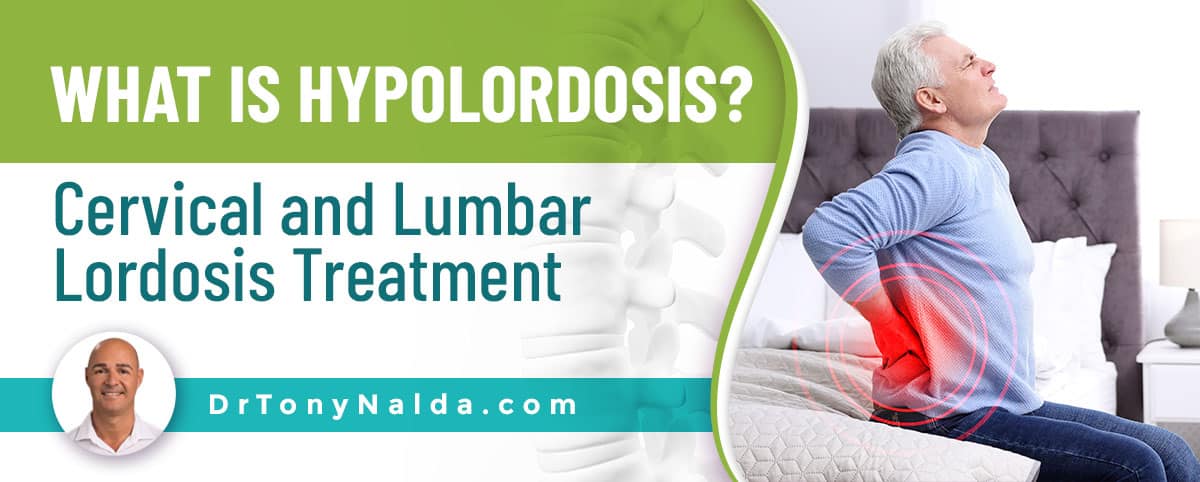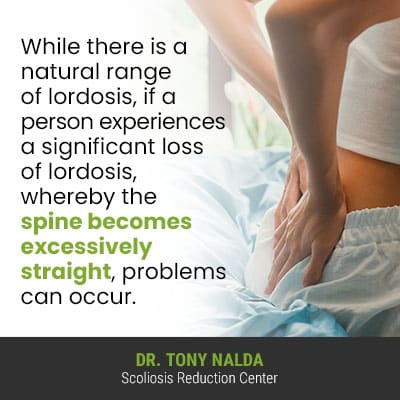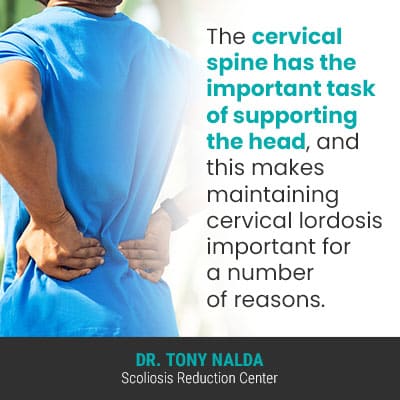What Is Hypolordosis? Cervical and Lumbar Lordosis Treatment

A spine that's able to maintain its natural and healthy curves is a spine that's aligned, and this allows it to function optimally. There are a number of spinal conditions that involve a loss of the spine's healthy curves, and when the spine's inward curvatures, known as lordosis, become excessively straight, this is known as hypolordosis.
The spine's natural curves give it strength, flexible movement, and absorb mechanical stress. Hypolordosis is a spinal condition that involves a loss of the spine's natural lordosis: spinal-curve type that bends inwards, towards the body's center at the cervical and lumbar spinal sections.
A basic understanding of spinal anatomy is helpful when exploring spinal conditions like hypolordosis, so let's start with the overall structure of the spine.
Table of Contents
Basic Spinal Anatomy
The spine is made up of vertebrae (bones) stacked on top of one another in a straight and neutral alignment.
Adjacent vertebrae are separated by an intervertebral disc that provides cushioning, structure, and acts as the spine's shock absorbers.
When viewed from the sides, a healthy spine will have a soft 'S' shape, and when viewed from the front and/or back, it will appear straight; this is due to the spine's natural and healthy curves in each section.
The spine has three main sections: cervical spine (neck), thoracic spine (middle/upper back), and lumbar spine (lower back).
Each spinal section has a characteristic curvature type. Kyphosis is when the spine curves backwards, away from the body's center in a reverse C-shape; lordosis refers to the spine's curves that bend forwards towards the body's center in a standard 'C' shape.
The cervical spine and lumbar spine feature lordotic curves, while the thoracic spine features a kyphotic curve.
 While there is a natural range of lordosis, if a person experiences a significant loss of lordosis, whereby the spine becomes excessively straight, problems can occur.
While there is a natural range of lordosis, if a person experiences a significant loss of lordosis, whereby the spine becomes excessively straight, problems can occur.
What is Hypolordosis?
To break down the term hypolordosis, hypo is Greek for under and lordosis means bending backwards, so a person diagnosed with hypolordosis has experienced a flattening of the spine's natural lordosis.
When the spine loses one or more of its natural curves, adverse spinal tension is introduced, putting stress on the spine's frontal plane (discs and vertebrae).
Adverse spinal tension causes compression of the discs and the vertebrae, and having an excessively-flat spine unnaturally elongates the posterior back muscles; it can shorten the hamstrings and pull on the anterior hip flexor muscles, elongating them unnaturally, and this can cause pelvic tilt where the front of pelvis lifts up while the pelvis is lowered at the back.
The body will naturally try to counteract uneven forces introduced by spinal conditions like hypolordosis; as unnatural structural changes occur, it can try and maintain balance through muscle contractions/relaxations that happen throughout the body.
The extra expenditure of energy needed to maintain balance and equilibrium can disrupt the neuro-musculo-skeletal system, making the back vulnerable to chronic strain, trigger points, joint pain/inflammation, disc degeneration, vertebral compression fractures, headaches, and abnormal neuro-muscular function.
Remember, the spine and brain work together to form the central nervous system (CNS), which facilitates brain-body communication so is involved in the function of virtually every system at work within the body; this is why spinal conditions can cause such a wide range of seemingly-unrelated symptoms felt throughout.
So now that we've defined the condition hypolordosis, let's talk about some of its common symptoms.
What Are The Symptoms of Hypolordosis?
When it comes to hypolordosis symptoms, each case is unique and shaped by a number of key patient/condition variables: patient age, spinal location, and severity.
In most spinal conditions, the area of the body located closest to the affected spinal section is the area most likely to feel its direct effects, but when there is a degree of nerve involvement, symptoms can be felt throughout the body.
 The cervical spine has the important task of supporting the head, and this makes maintaining cervical lordosis important for a number of reasons.
The cervical spine has the important task of supporting the head, and this makes maintaining cervical lordosis important for a number of reasons.
Hypolordosis of the Cervical Spine
The neck is important for overall health; it connects the brain to the rest of the body and helps facilitate communication between the brain and the rest of the body.
A healthy cervical spine curvature will have a wide 'C' shape, with an anterior curve (inward), and this curve is important for supporting the weight of the head and facilitating a wide range of motion in the neck.
The cervical spine consists of the first seven vertebrae of the spine, extending from the base of the skull to the first vertebral body of the thoracic spine.
When the neck experiences a loss of its cervical lordosis, becoming excessively straight (flatter), a condition known as military neck is a common complication: named after the soldier's pose of standing at attention and holding the body excessively straight.
Another common complication that can develop is what's known as forward head posture, and this is related to the cervical spine shifting forward in posture due to the neck becoming excessively straight, and this increases the weight of the head on the neck and can cause symptoms like neck pain, tension headaches, and strained neck and shoulder muscles.
So when the cervical spine's lordosis is lost and becomes excessively straight, this is diagnosed as hypolordosis of the cervical spine.
Hypolordosis of the Lumbar Spine
Hypolordosis of the lumbar spine affects the lower back as it involves a loss of the lumbar spine's natural and healthy curve, and this can lead to a condition known as flatback syndrome: a front-to-back interruption to the lumbar spine's balance and stability.
The lower back's curve starts at the first vertebra of the lumbar spine and extends to the top of the sacrum: triangular-shaped bone between the hips of the pelvis).
Lumbar hypolordosis can cause a number of issues as it introduces adverse spinal tension that makes the vertebrae and intervertebral discs vulnerable to degeneration and injury.
The lumbar spine is vulnerable to a number of spinal conditions/issues because it has to support the weight of the spinal sections above, the entire trunk, and also feels the effects of lifting, bending, and twisting motions.
Common symptoms of hypolordosis of the lumbar spine can include lower back pain, a reduced range of motion in the lower body, radicular pain (a variety of sensations felt throughout the lower body), and changes to gait and balance.
Treatment for Hypolordosis
Treatment for hypolordosis of the cervical spine will focus on restoring spinal flexibility and range of motion in the neck, and treatment for hypolordosis of the lumbar spine will focus on restoring flexibility/range of motion in the lower back
As is the case in a variety of spinal conditions, treatment needs to be multifaceted.
Here at the Scoliosis Reduction Center, patients have access to multiple different hypolordosis treatment options under one roof.
I combine targeted chiropractic adjustments, therapy, specific exercises, and rehabilitation; together, these treatment modalities complement one another and work towards relaxing tight muscles so bones can be manipulated back into a better position, improving spinal alignment.
Part of my treatment also involves improving efficacy in parts of the brain that play a role in maintaining healthy posture, balance, reflexes, and coordination.
I also closely monitor the spine to see how it's responding to treatment. I take X-ray images in the same position pre- and post-treatment so I can confirm that the cervical spine and/or lumbar spine have restored their natural and healthy degrees of lordosis.
Custom-prescribed exercises are also a key facet of treatment as increasing core strength can mean optimal spinal support provided by its surrounding muscles.
Conclusion
The spine enables us to retain a standing position, engage in flexible movement, and absorbs mechanical stress incurred during movement.
In addition, the spine and brain work in tandem to form the central nervous system (CNS), so plays a key role in brain-body communication.
The spine's overall health, biomechanics, and function are determined by its ability to maintain its natural curves and alignment.
There are a number of spinal conditions that involve a loss of the spine's healthy curves, from unnatural sideways spinal curves, to excessive curves, and curves that are lost due to the spine becoming too straight; here at the Center, I've treated them all.
When hypolordosis is present in the cervical or lumbar spine, this means the spinal section affected has lost its healthy lordosis and, instead, has become excessively straight, and this can cause the development of military neck and/or flatback syndrome.
By committing to a proactive and integrative conservative treatment plan, the spine's natural curves can be restored, along with the spine's biomechanics, while symptoms are reduced alongside the unnatural spinal curve.
Dr. Tony Nalda
DOCTOR OF CHIROPRACTIC
After receiving an undergraduate degree in psychology and his Doctorate of Chiropractic from Life University, Dr. Nalda settled in Celebration, Florida and proceeded to build one of Central Florida’s most successful chiropractic clinics.
His experience with patients suffering from scoliosis, and the confusion and frustration they faced, led him to seek a specialty in scoliosis care. In 2006 he completed his Intensive Care Certification from CLEAR Institute, a leading scoliosis educational and certification center.
About Dr. Tony Nalda
 Ready to explore scoliosis treatment? Contact Us Now
Ready to explore scoliosis treatment? Contact Us Now





